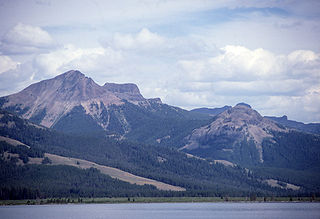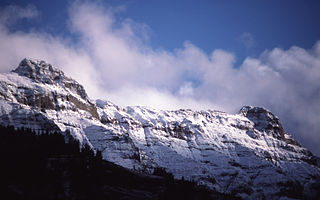
The Absaroka Range is a sub-range of the Rocky Mountains in the United States. The range stretches about 150 mi (240 km) across the Montana-Wyoming border, and 75 miles at its widest, forming the eastern boundary of Yellowstone National Park along Paradise Valley (Montana), and the western side of the Bighorn Basin. The range borders the Beartooth Mountains to the north and the Wind River Range to the south. The northern edge of the range rests along I-90 and Livingston, Montana. The highest peak in the range is Francs Peak, located in Wyoming at 13,153 ft (4,009 m). There are 46 other peaks over 12,000 ft (3,700 m).

Eagle Peak is a mountain in the Absaroka Range in the U.S. state of Wyoming and at 11,372 feet (3,466 m) is the highest point in Yellowstone National Park. It is located about 6 miles (9.7 km) east of the southeast arm of Yellowstone Lake.

Mount Schurz el. 11,007 feet (3,355 m) is a mountain peak in the Absaroka Range in Yellowstone National Park. Mount Schurz is the second highest peak in Yellowstone. The mountain was originally named Mount Doane by Henry D. Washburn during the Washburn–Langford–Doane Expedition in 1871. Later the name Mount Doane was given to another peak in the Absaroka Range by geologist Arnold Hague. In 1885, Hague named the mountain for the 13th U.S. Secretary of the Interior, Carl Schurz (1877–1881). Schurz was the first Secretary of the Interior to visit Yellowstone and a strong supporter of the national park movement.

Mount Hornaday el. 10,003 feet (3,049 m) is a mountain peak in the northeast section of Yellowstone National Park in the Absaroka Range, Wyoming. The peak was named in 1938 for naturalist William Temple Hornaday, a former director of the New York Zoological Gardens who championed the cause of saving the American Bison from extinction.

Colter Peak el. 10,640 feet (3,240 m) is a mountain peak in the Absaroka Range in the southeastern section of Yellowstone National Park. The peak is named for mountain man John Colter, reputedly the first white man to visit the Yellowstone region. Colter Peak was first ascended in 1870 by Lt. Gustavus Cheyney Doane and Nathaniel P. Langford during the Washburn–Langford–Doane Expedition. Henry D. Washburn, the expedition leader named the peak for Langford and Doane. For unknown reasons, geologist Ferdinand V. Hayden moved those names to peaks farther north in 1871 during the Hayden Geological Survey of 1871. In 1888, Philetus Norris the second park superintendent, named the peak Mount Forum for unknown reasons. In 1885, geologist Arnold Hague gave the peak its official name: Colter Peak.

Abiathar Peak el. 10,928 feet (3,331 m) is a mountain peak in the northeastern section of Yellowstone National Park of Absaroka Range. The peak was named by members of the 1885 Hague Geological Survey to honor Charles Abiathar White, a geologist and paleontologist who had participated in early western geological surveys. White never visited Yellowstone.

Barronette Peak el. 10,354 feet (3,156 m) is a mountain peak in the northeast section of Yellowstone National Park in the Absaroka Range. The peak is named for Collins Jack Baronette (1829–1901). It was named by the Hayden Geological Survey of 1878. When named, the name was misspelled Barronette and it retains the official misspelled name today.

Mount Norris el. 9,842 feet (3,000 m) is a mountain peak in the northeast section of Yellowstone National Park in the Absaroka Range. In 1875, the peak was named for and named by Philetus Norris, the second park superintendent (1877–1882). Norris was on a visit to the park with several mountain guides, including Collins Jack Yellowstone Jack Baronette. They ascended the peak at the head of the Lamar Valley and presumed they were the first white men to do so, thus naming it Mount Norris.

Barlow Peak el. 9,609 feet (2,929 m) is an isolated mountain peak in the Big Game Ridge section of southwest Yellowstone National Park south of the Continental Divide. Barlow peak was named by geologist Arnold Hague in 1885 for Captain John W. Barlow an early topographical engineer mapping in the park.

Cook Peak el. 9,754 feet (2,973 m) is a mountain peak in the Washburn Range of Yellowstone National Park. The peak was named in 1922 by then superintendent Horace Albright to honor of Charles W. Cook, a member of the 1869 Cook–Folsom–Peterson Expedition which explored the Yellowstone park region. 1922 was the 50th anniversary of the park's creation, and Charles Cook, still living in Montana, attended ceremonies in the park. Prior to 1922, the peak had been named Thompson Peak by Philetus Norris in 1880 and Storm Peak by members of the Arnold Hague Geological Surveys in 1885.

Folsom Peak el. 9,334 feet (2,845 m) is a mountain peak in the Washburn Range of Yellowstone National Park. The peak was named in 1895 by geologist Arnold Hague to honor David E. Folsom, a member of the Cook–Folsom–Peterson Expedition of 1869. Folsom, Peterson and Cook were some of the 1st explorers of the Yellowstone region to publish their exploration.

Dunraven Peak el. 9,869 feet (3,008 m) is a mountain peak in the Washburn Range of Yellowstone National Park. In 1874, just two years after the park's creation, the Earl of Dunraven, a titled Englishman made a visit to Yellowstone in conjunction with a hunting expedition led by Texas Jack Omohundro to the Northern Rockies. He was so impressed with the park, that he devoted well over 150 pages to Yellowstone in his The Great Divide, published in London in 1874. The Great Divide was one of the earliest works to praise and publicize the park.

Hedges Peak el. 9,669 feet (2,947 m) is a mountain peak in the Washburn Range in Yellowstone National Park. The peak was named in 1895 by geologist Arnold Hague to honor Cornelius Hedges (1837–1907), a member of the Washburn–Langford–Doane Expedition of 1871 and prominent Montana lawyer. Hedges accounts of the expedition in Helena Daily Herald newspaper contributed to the campaign to create Yellowstone National Park. Prior to 1895 the peak had been named Surprise Peak by geologist J.P. Iddings in 1883.

Terrace Mountain is a mountain peak in the Gallatin Range in Yellowstone National Park, Wyoming, United States. The mountain is located 2.2 miles (3.5 km) southwest of Mammoth Hot Springs. Terrace Mountain was named by the 1878 Hayden Geological Survey because of its proximity to the travertine terraces at Mammoth and because it too is an ancient travertine terrace. The mountain has also been known as "Soda Mountain" and "White Mountain".
Atkins Peak el. 10,928 feet (3,331 m)is a mountain peak in the eastern section of the Absaroka Range in Yellowstone National Park.

Joseph Peak el. 10,420 feet (3,180 m) is a mountain peak in the southern section of the Gallatin Range in Yellowstone National Park. It was named for Chief Joseph.

Echo Peak el. 9,570 feet (2,920 m) is a mountain peak in the southern section of the Gallatin Range in Yellowstone National Park.

Bannock Peak el. 10,292 feet (3,137 m) is a mountain peak in the southern section of the Gallatin Range in Yellowstone National Park.
Three Rivers Peak el. 9,764 feet (2,976 m) is a mountain peak in the southern section of the Gallatin Range in Yellowstone National Park.



















